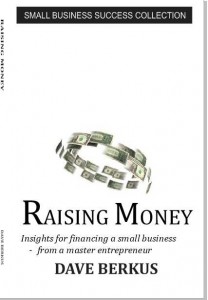Here’s more advice from professional investors for aspiring entrepreneurs. Each of us has a list of things we look for early on when identifying whether we want to go to the next step in analyzing a plan. Come to think of it, these are good for challenging any business plan.
First: You must address a big market, large enough to allow a new entrant to have a shot at making a dent with a great product or service, and growing to a size that will make the company valuable at the exit. We often draw the line at believing that a company can capture enough of the market to generate over $40 million in revenues by the fifth year in the market. Many, many businesses will never be able to obtain this kind of market  size or share. And often, these are the ones that will be bypassed by most organized angel groups when considering funding. Your big market can come from having a dominant share or just by being in a very large space. Both work – with the dominant share being preferred.
size or share. And often, these are the ones that will be bypassed by most organized angel groups when considering funding. Your big market can come from having a dominant share or just by being in a very large space. Both work – with the dominant share being preferred.
[Email readers, continue here…] Second, you must have and be able to tell an easy to understand story to your prospective customers, suppliers and investors. If your product is too complex to describe in a few words, your opportunity to sell it will suffer, and investors will quickly lose interest or the ability to follow your explanation. I’ve often repeated that entrepreneurs must construct a short, single sentence “mantra” that explains what you do in as few words as possible, sometimes using the name of a well-known company as a proxy for your activities. “We are the Skype of Internet one-to many interactive broadcasting.”
And third, you must have some “secret sauce” that is unique, and makes you and your offering stand out among the thousands of possible competitors. What gives you a head start, a barrier to entry, an extra value that others cannot easily emulate? Secret sauce is important to investors and to you in competing against a company with more money, a brand name, or a head start.
A big market. An easy-to-understand story. Secret sauce. Why not spend a few minutes right now, and explain to yourself how you address each.






Dave,
You are absolutely right on point. I cannot tell you how many pitches I have listened to that leave me scratching my head trying to understand their product and/or value prop. I am coaching a company right now on this very point and will share your email with the three simple steps to reinforce what they need to focus on. Thanks!
Linda
Here is how I would explain these three essential element of our business plan:
Big Picture, Few Words:
GEMtech is endeavoring to roll up the current generation of lodging Guest Experience Management solutions Those solutions are vertical fragmented, mostly legacy and often nonexistent. When fully realized, the GEMtouch solution set will allow independent and enterprise lodging operators to truly Manage and Yield ALL Guest Experiences during their stay.
Secret Sauce:
A single, N-tier Resource, Rules driven, Rate and Availability engine for ALL guest experiences with the ability to provide solutions where none exist or integrate the 3rd party solutions that do exist. This aggregated and rationalized ability would then be exposed to internal and external sales channels.
Big Market:
I gave our presentation to the right VP at IHG last week. He validated their need for the Enterprise GEMtouch Solution set as well as the lack of existing solutions. He estimated 40% of his 3,200+ properties could use GEMtouch. Based on recent experience, we believe that the market potentiality for GEMtouch is roughly 35% of MICROS’ Opera annual revenues which would be about $98,775,000
We define Guest Experiences to include: Transportation, Golf, Youth Programs, Guest Incident Resolution, Spa\Salon, Amenity Sales and Delivery, Dining Reservations, Fitness Classes, Racquet Sports, Property Memberships and so on.
Would you say this meets the criteria?
Brian,
The “big market” story of your presentation to the IHG VP is the most dramatic statement you have, validating what you say. You might consider starting your presentation with this comment to get our attention. Either way, find words for the secret sauce that are not so technical that investors will be left behind. “A rules-driven intelligent engine that integrates all forms of guest experience into one process is revolutionary…”
Dave
Responding to Harry’s comments above:
Testimonials almost always outperform an entrepreneur’s detailed description of the product or process for investors. The latter can come after you grab the attention of the investor with short, impactful testimonials.
As far as popping up on the radar of competitors, that will happen as soon as their salespeople see you as a threat, no matter what level of revenues. Speed in development, quality of product -presentation, and competitive pricing all help push away competition. Remember that competitor interest validates that what you are doing is right on point and potentially harmful to the competition. If you are good enough at doing this, your competitor may become an aggressive buyer of the business someday. If you are enough of a threat, you may even find them to be an “emotional buyer” (see an earlier BERKONOMICS post about this)…
Dave
So right!
You should ask yourself these same questions before starting your venture.
My biggest problem in pitching is part 2, where I tend to explain everything we have. It’s just so exciting that I have trouble holding back.
Our market currently (hoping to expand it someday) is all online science labs and amounts to roughly a billion dollars worldwide, not truly huge. With expansion to other areas using the same technology, it could be larger. From where we are today, we could reach $40 million in five years, but I’m aiming for $10 million in 3-4 years. I’d be happy to turn over the company to someone else to expand beyond $10MM.
Our business proposition is solving the science education problem with online real labs.
And that’s our special sauce. Our approach to online labs is totally different than all of those simulated labs. It’s real, and it’s patented.
Here’s my question. How deeply must I go to explain the business proposition? I have two high-profile clients today (California State University and Discovery Education) with more to come.
Must I explain the science education problem? How do I explain that the connection between real labs and learning science is critical? Will testimonials be better than my dry scientist’s explanation?
The biggest issue for us today hasn’t been covered yet in these columns and may be useful for others to figure out too. Once we hit $1MM in revenue next year, we will suddenly appear on the radar of the big players in our industry. The typical response of these guys is “buy or bury.” Chances are that we won’t be generating revenue fast enough to have the explosive growth necessary to avoid being buried and that the buy proposition will undervalue us. While I can hope that neither of these happens, it’s likely that both will.
I’d rather not wait until the crisis hits to find a good partner/investor to ensure that we survive and thrive. It can work either way — by being bought for a good price or by growing enough to make burying us too expensive for the potential return.
When in the growth process is the right time to seek out the right partner/investor(s)?
I totally agree that these three elements are ESSENTIAL! but, i confess, i have grown wary of “we’re the X of Y” pitches, like, “we’re the AirBNB of Tennis Courts.” usually seductively false.